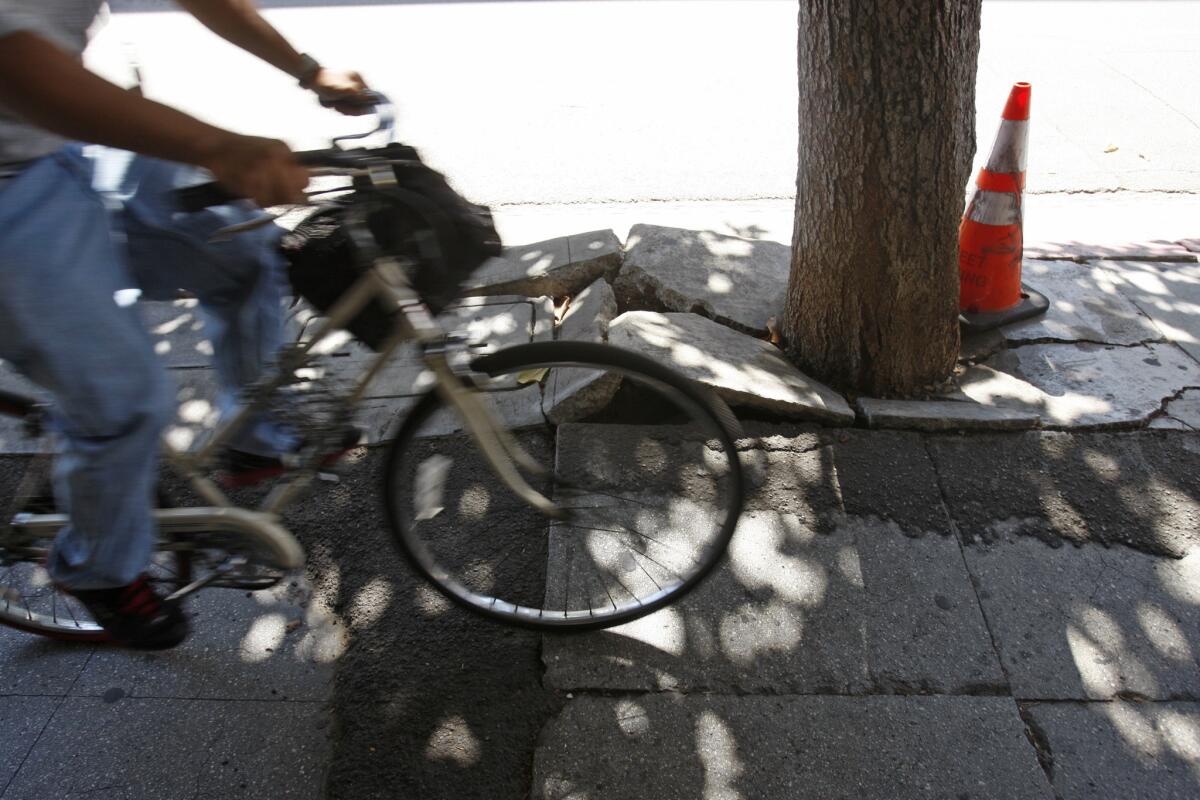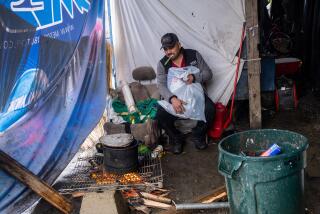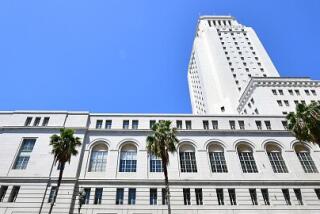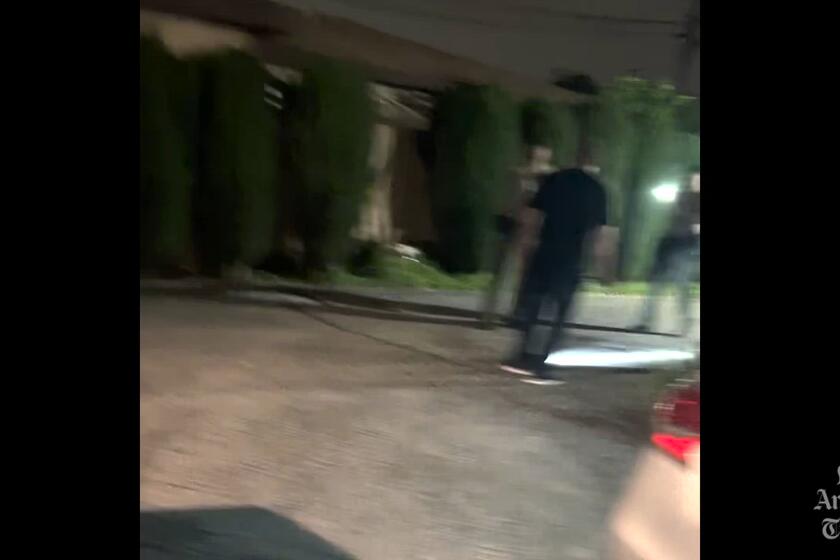L.A. agrees to spend $1.3 billion to fix sidewalks in ADA case

A buckled sidewalk at 4th and Main streets in downtown L.A.
Los Angeles is pledging to spend more than $1.3 billion over the next three decades to fix its massive backlog of broken sidewalks and make other improvements to help those with disabilities navigate the city as part of a tentative deal being described as a landmark legal settlement.
The proposed agreement would resolve a lawsuit filed by attorneys for the disabled, who argued that crumbling, impassable sidewalks and other barriers prevented people in wheelchairs or others with mobility impairments from accessing public pathways in violation of the Americans With Disabilities Act.
The final terms must still be approved by a federal judge, but attorneys described it as the biggest agreement of its kind in U.S. history.
City leaders said the proposed deal marks the beginning of a sorely needed effort to eliminate one of Los Angeles’ most intractable neighborhood nuisances: the ugly and treacherous obstacle courses created by miles of buckling walkways.
City officials and advocates for the disabled praised the agreement at a news conference. Communities Actively Living Independent and Free Executive Director Lillibeth Navarro, whose group was among those suing the city, called it “a major win” for people with disabilities who had suffered frustration and injuries trying to move around the city. Councilman Paul Krekorian said it was a historic victory not only for people with disabilities, but also for the elderly and “anyone who is ever a pedestrian.”
Under the terms of the proposed settlement agreed to by the City Council and announced Wednesday, the city must spend $31 million annually on sidewalk and other improvements beginning in the next budget year. That amount would gradually increase to $63 million in future years to adjust for rising costs.
The settlement doesn’t identify any new source of funding. But City Administrative Officer Miguel Santana noted that the deal does not limit the type of funding Los Angeles can use to pay for the repairs, meaning the city could seek various grants for the work.
It’s unclear whether the promised money will completely eliminate the backlog. The Bureau of Street Services has estimated that about 40% of city sidewalks need repairs. At one point, the price tag was estimated at $1.5 billion. But Santana said there is no reliable estimate for the full cost.
UCLA urban planning professor Donald Shoup said: “It’s sad to think that the only thing that has caused any movement in 40 years is a lawsuit.… But of course I’m glad they’re doing it.”
Even with the promised spending, he added, “It would take decades to fix our sidewalks.”
Mayor Eric Garcetti said he believed the spending would be enough to stay ahead of any ongoing deterioration of aging city sidewalks. Attorney Guy Wallace, one of several lawyers representing plaintiffs in the case, said the record agreement was larger than a major, $1.1-billion settlement reached several years ago with Caltrans, the state transportation agency.
The Los Angeles suit alleged that lack of public access for Angelenos in wheelchairs “relegates them to second-class citizen status” and prevents them from being independent. Wallace said at a news conference that more than 200,000 Angelenos with mobility disabilities had struggled to navigate “dysfunctional and inaccessible” sidewalks. Tim Fox, a Denver-based attorney who is on the national board of the American Civil Liberties Union, said the settlement represented an unprecedented move by a city to broadly improve access to its sidewalks for the disabled.
The city plans to start by repairing sidewalks around parks and other city facilities, but will also fix walkways in other areas that are heavily trafficked, close to hospitals or workplaces, or requested by people with mobility challenges, including those alongside homes, Santana said. The only sidewalks that would be categorically left out are those next to buildings run by other government entities, including the Los Angeles Unified School District or federal or state agencies.
Funding to fix sidewalks has been haphazard over the years, and the city abandoned any systematic sidewalk repair program after the recession hit seven years ago. As the economy has improved, the city has revived its program and budgeted $27 million for repairs this year.
So far, Los Angeles has focused its efforts on walkways next to parks and other city facilities. Some council members have also devoted money from their discretionary funds to fix sidewalks in their districts. But the problem remains glaringly obvious in many areas and has cost the city more than $6 million in trip-and-fall payouts in less than four years, according to the city attorney’s office.
Kathleen Law, 73, a Hollywood resident whom the city paid $50,000 after she tripped on a jagged sidewalk and shattered her right knee cap in 2008, said the plan was overdue.
“It’s absolutely a must,” said Law, adding that she still suffers pain from her injury and has had to drastically curtail her preferred form of exercise — walking. “There are some streets I just can’t walk on because it’s too risky.”
The deterioration of city sidewalks is tied to a historic tug of war over who is responsible for fixing them. Los Angeles once held property owners responsible for fixing the adjacent sidewalks, conforming with California law. But decades ago, with federal funding in hand, the city took on responsibility for fixing sidewalks damaged by city trees.
That federal money quickly dried up and Los Angeles voters proved unwilling to pony up more tax money to continue repairs. In 1998, a move to authorize $769 million in bonds for sidewalk work was rejected. Last year, lawmakers abandoned a plan to ask voters to hike the sales tax to pay for street and sidewalk repairs.
Shoup argued that the city should pursue additional measures, including requiring owners to fix broken sidewalks next to their property when they sell.
The proposed settlement is silent on who is legally responsible for sidewalks next to private property — leaving the door open for that kind of program, Shoup suggests. Santana said city lawmakers still have to grapple with those types of issues.
Under the terms announced Wednesday, the city can reduce its annual spending slightly — to $25 million — but it must make up for it within the next three years.
With the City Council’s approval of the settlement terms, city lawyers can present a final agreement to the court.
In addition to the $1.3 billion pledged for repairs, the city will pay $15 million in attorneys fees and costs. Wallace said the city is also creating a position to monitor the work and will draft reports on its progress twice yearly.
Follow @latimesemily for what’s happening at Los Angeles City Hall
More to Read
Start your day right
Sign up for Essential California for news, features and recommendations from the L.A. Times and beyond in your inbox six days a week.
You may occasionally receive promotional content from the Los Angeles Times.







